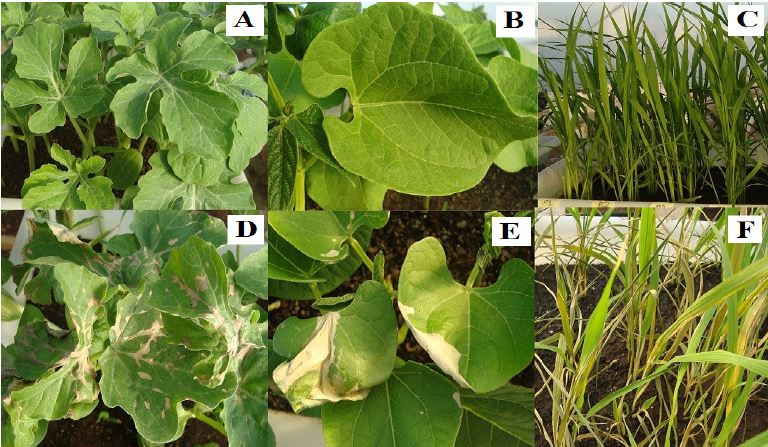Phytotoxicity of essential oils in watermelon, bean, and rice plants
DOI:
https://doi.org/10.20873/jbb.uft.cemaf.v5n2.brumKeywords:
Medicinal plants, injuries, Citrullus lanatus, Phaseolus vulgaris, Oryza sativaAbstract
The purpose was to evaluate the action of the citronella (Cymbopogon nardus), lemongrass (Cymbopogon citratus), lemon balm (Lippia alba) and peppermint (Mentha piperita) essential oils on watermelon (Citrullus lanatus), bean (Phaseolus vulgaris), and rice (Oryza sativa) plants. To each culture, it was used a completely randomized design in factorial scheme with four replications, in which the factors were four essential oil types and four oil concentrations (0.5; 1; 2; and 4%). Eighteen days after planting, plants were sprayed with the solutions of the essential oils, and after twenty-four hours the phytotoxicity evaluation was done by using a scale from zero (0) (no phytotoxicity) to one hundred (100%) (total plant wilting). The 2% concentration of the assessed essential oils was phytotoxic for the three plant species. In watermelon plants, the highest phytotoxicity was shown by the lemongrass oil, which in concentrations of 2 and 4% showed toxicity of 75 and 68.75%, respectively. Beans were the least sensitive to the essential oils, they showed 50% of phytotoxicity when subjected to 4% citronella and lemongrass oils. Occurred wilting and drying of rice plants under 4% peppermint and citronella oils.

Published
How to Cite
Issue
Section
License
Copyright (c) 2024 - Journal of Biotechnology and Biodiversity

This work is licensed under a Creative Commons Attribution 4.0 International License.
Authors who publish with this journal agree to the following terms:
Authors retain copyright and grant the journal right of first publication with the work simultaneously licensed under a Creative Commons Attribution License (CC BY 4.0 at http://creativecommons.org/licenses/by/4.0/) that allows others to share the work with an acknowledgement of the work's authorship and initial publication in this journal.
Authors are able to enter into separate, additional contractual arrangements for the non-exclusive distribution of the journal's published version of the work (e.g., post it to an institutional repository or publish it in a book), with an acknowledgement of its initial publication in this journal.
Authors are permitted and encouraged to post their work online (e.g. in institutional repositories or on their website) prior to and during the submission process, as it can lead to productive exchanges, as well as earlier and greater citation of published work (Available at The Effect of Open Access, at http://opcit.eprints.org/oacitation-biblio.html).


